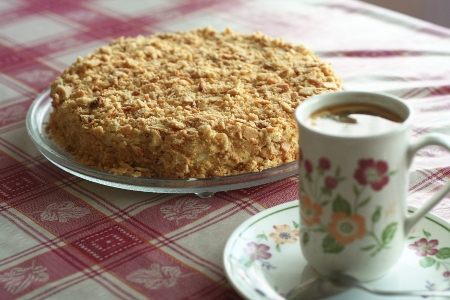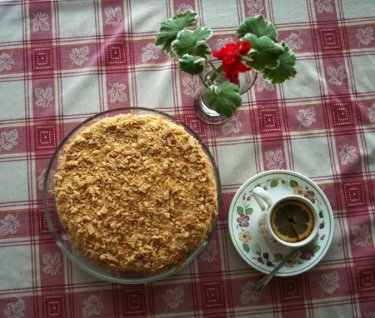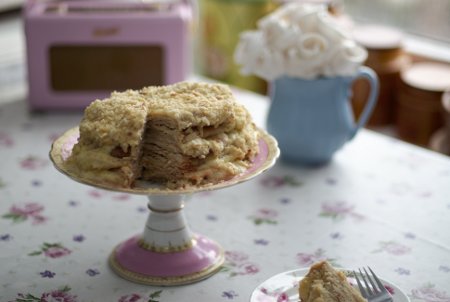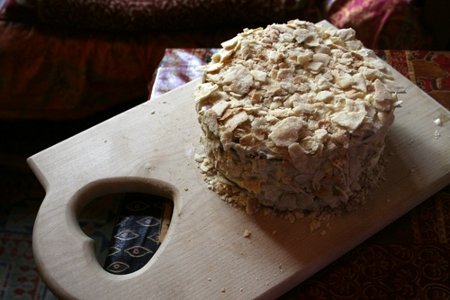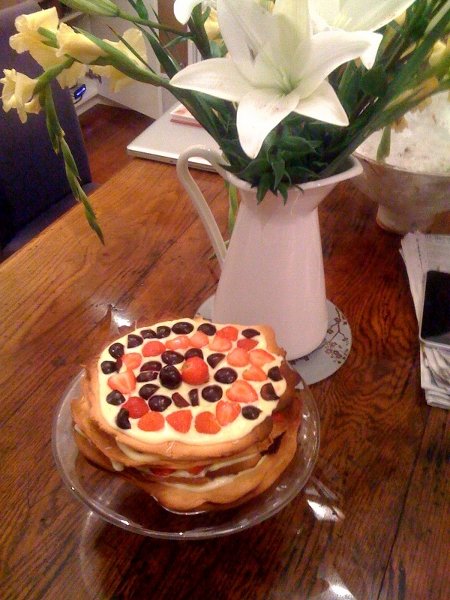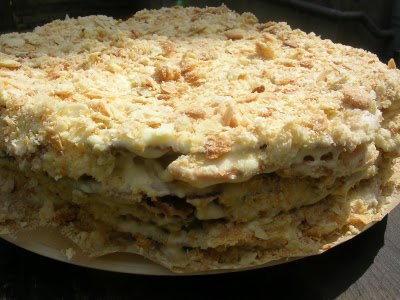| Kitchen Living Room Bedroom Toilet Hall |
TAKE THE NAPOLEON CAKE CHALLENGE! This is a Mille-feuille cake - literally 'thousand-leaf'. This means layers. And this is where the 'challenge' part comes in (though this recipe is quite a few short of 1,000 layers). In Moscow, big trays of Napoleon were made for birthdays. I had the impression they took about two days to make. This is a French creamy-layer cake that the Russians have made their own. The stunning Napoleon featured here has been made by Zhenya, a competent cook and also an engineer - the perfect combination for assembling this cake. To take the Cake Challenge check out Zhenya's recipe below and then make your own. Send a photo of your creation, plus a short commentary on the making process, to amy@amyspurling.com. And the results may even appear here!
ZHENYA'S NAPOLEON RECIPE
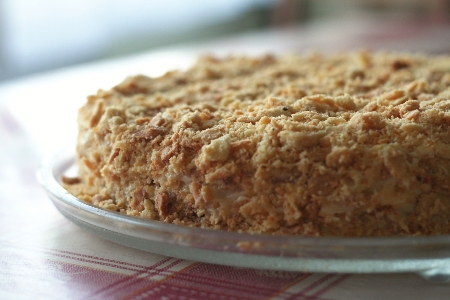 photo by Andriy Bychay
1 egg 250g soft butter or margarine 540g flour juice of 1/2 lemon 1/2 teaspoon salt 125 ml water (cold)
For the cream:
What happened when several bloggers tried to make Russia's legendary layer cake Amy - "it didn't take two days to make"
When I decided to take my own Cake Challenge, we ended up eating cake for a week. The Napoleon wasn't as difficult to make as I'd anticipated, however. It didn't take two days, for example. Although it did come out pear-shaped, and I practically got a tan opening my oven door to extract the layers (250 C is the hottest my oven goes). I then twisted some arms, the results of which you can see below. There have been a few comments about the rather generous amounts of butter used in this recipe (the word 'mountains' has been used). And while I did feel that I was putting on weight just looking at my Napoleon, all are agreed that this cake is very doable and very delicious. In Moscow, we used to wash it down with vodka. No sense in doing things by halves, after all. You should probably accompany it with a strong drink, but if you don't want something quite that strong, Katrina (see below) suggests black tea or Turkish (sweet black) coffee. Chaz - "the first two layers came out looking like poppadoms"
"I halved the recipe, as I believe there's something quite alarming about anything that requires over a pound of butter to make, but for the sake of simplicity I used the same amount of egg and lemon juice. When about to juice the lemon, I decided to zest the rind and add that to the butter and condensed milk for the cream. Waste not want not... To get a similar shape for each layer, I cut around a bowl after rolling out. I also remembered to prick them before baking after the first two came out looking like poppadoms. I beat the condensed milk, butter and lemon zest together and used it to glue the pastry into a stack. The resulting stack was over 3 inches high and there wasn't quite enough cream to go round. We had it after supper and it tasted lovely!" A good old fashioned one hundred and twenty unit week... Nat - "I didn't realise we had a rolling pin so I used a beer bottle"
"I crushed a layer to generate the crumbs, but thought it would be a shame to cover my strawberry garnish, so I just ate them (the crumbs). The hardest bit was fitting all those layers in the oven and rolling them out - I didn't realise we had a rolling pin so I used the beer bottle I happened to be enjoying the contents of. Unfortunately it was too curvaceous to give a very even roll. There wasn't nearly enough of the cream to assemble the structure I had in mind. Didn't bother with the fridge stage. The cream was pretty nice when I licked it off the Magimix blades (do not do this at home)." Katrina - "My guests ravenously ate the whole cake in some 20 minutes"
"In Russia the most iconic version - or the most Soviet, depending on how you look at it - is made with condensed milk cream, that cloyingly sweet and terrifyingly addictive substance. Unlike the 'proper' French Mille-feuille, where the top is often covered by patterned icing, the Russian version is topped with crumbled pastry. The budget version if you like. I have numerous memories of my mother making Napoleons for me, often in preparation for various school events, such as the ceremony of becoming a Pioneer. I made the Napoleon last night for our big house warming party. The process was surprisingly straight-forward, the result head-spinningly good. ...My guests ravenously ate the whole cake in some 20 minutes, greedily licking up crumbs and drops of cream. I had to restrain some of them. Nostalgia combined with sugar and fat - the most powerful mix in the world." Read Katrina's full Napoleon entry Cake Dr.Some tips from Katrina on how to avoid sticky Napoleon moments.
|
|
All text and images copyright 2010-17 Amy Spurling unless otherwise noted |
